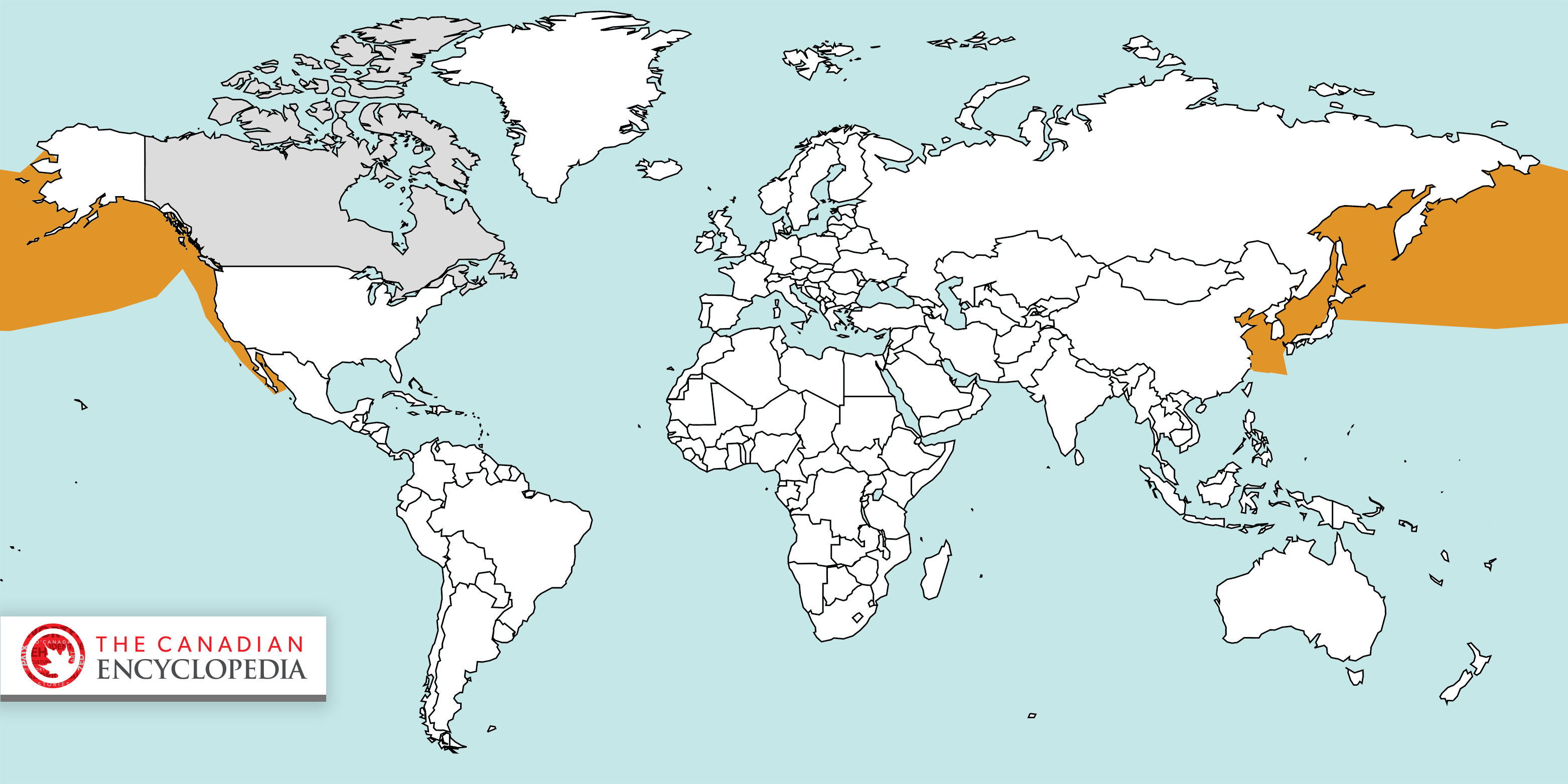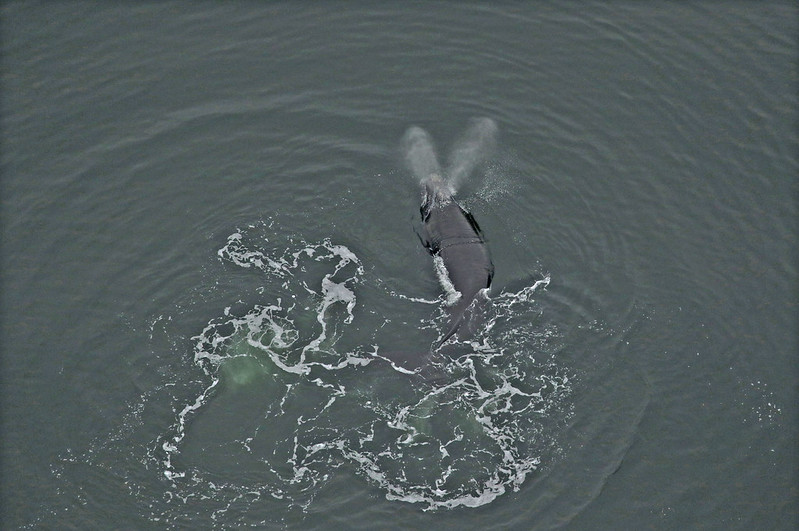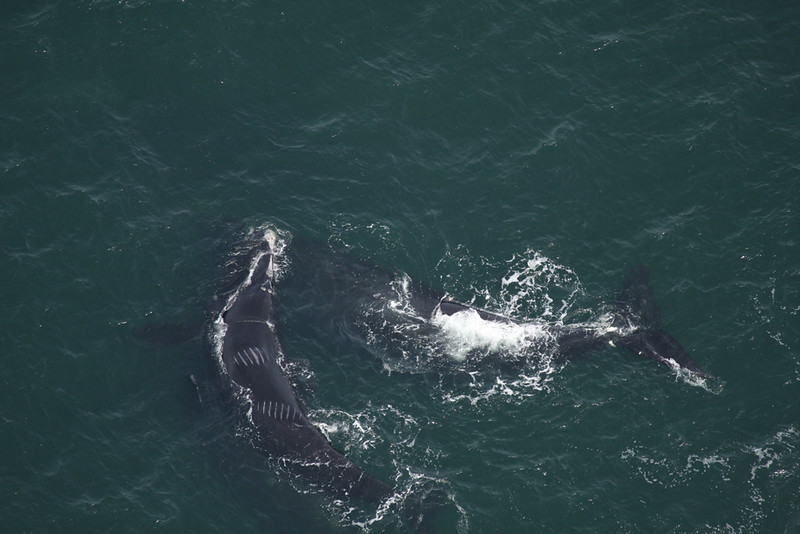Right whales are a baleen whale found in the Atlantic, Pacific, and Indian Oceans. There are three species: the North Pacific right whale (Eubalaena japonica), North Atlantic right whale (Eubalaena glacialis) and southern right whale (Eubalaena australis). In Canadian waters, the North Pacific right whale is rarely sighted, but was historically found along British Columbia’s coast. The North Atlantic right whale is found along the Scotian Shelf and in the Gulf of St. Lawrence. Both the North Pacific and North Atlantic right whale are listed as endangered under Canada’s Species at Risk Act. (See also Endangered Animals in Canada.)
Physical Description

Right whales are mostly black with occasional white patches on their bellies. They are easily distinguished from other whales by their arched mouthline, lack of dorsal fin and rough patches of skin on or near their heads. These patches, known as callosities, are home to small crustaceans called cyamids (or “whale lice”). They show up as white or greyish bumpy areas. Each right whale has a unique pattern of callosities, allowing researchers to identify and keep track of individuals. Right whales can also be identified by their V-shaped blowhole spray (or blow). Stocky and rotund in shape, adult right whales reach up to about 16m in length and weigh over 63 tonnes. They are the third largest of all whales, behind the fin and blue whale. Right whales and their relative, the bowhead whale, have the longest baleen of all whales.
Distribution and Habitat

Right whales were historically common in the northern hemisphere, with large, separate populations across the Atlantic and Pacific oceans. Today, however, North Pacific right whales are almost never sighted in Canadian waters, but have been observed in small numbers in the Gulf of Alaska and the Bering Sea. Some scientists estimate the North Pacific right whale population numbers less than 100 individuals in the eastern North Pacific, and likely less than 250 throughout the North Pacific.

Scientists know more about North Atlantic right whales, which are also critically endangered. This population numbers fewer than 360 whales. North Atlantic right whales range from the Florida to Iceland. They typically spend winters off the southeastern coast of the United States and migrate north in the spring and summer to the northeastern United States and Atlantic Canada. In Canada, the nutrient-rich waters of the Grand Manan Basin in the Bay of Fundy, Roseway Basin off Nova Scotia, and the Gulf of St. Lawrence are all considered critical right whale habitats.
Reproduction
The natural lifespan of the North Atlantic right whale is at least 65 years, though actual life expectancy is shorter due to human threats. Females become sexually mature at around 10 years old and give birth to a single calf after a 12-to-13-month gestation. Calves are born during the winter, in warm, shallow waters near Georgia, northeastern Florida and the Carolinas. They nurse from their mothers for approximately one year.

Behaviour
Right whales feed almost exclusively on microscopic crustaceans called copepods. They capture copepods by swimming slowly with their mouths open and trapping prey in their baleen. Seawater continuously flows through the whales’ mouths thanks to the arched shape of their jaws. During this process, any copepods in the water are trapped by the fine hairs lining their baleen plates. North Atlantic right whales coordinate their migration with seasonal copepod abundance. They often feed by skimming the water’s surface, but can dive to depths of over 100 metres to access concentrated prey patches.
Right whales typically travel alone or in small groups, and they will occasionally form animated “surface active groups” (SAGs). Up to 40 whales may join these groups, engaging in mating, play or social bonding. Reproductive SAGs often start with vocalisations made by a single mature female. These sounds travel through the water and attract males from several kilometres away. The males jostle one another for a position close to the female and signal their intentions with sharp vocalisations that sound like gunshots.

Relationship to Humans
Right whales are presumed to be named by whalers for being the “right whale to hunt,” since they travel slowly, spend much of their time near shore, and, unlike most other whales, float after death (like its close relative, the bowhead whale).
The North Pacific right whale was likely among the species traditionally hunted by Indigenous peoples living in modern British Columbia, including the Kwakwaka'wakw and Nuu-chah-nulth peoples. In the North Atlantic, right whales were hunted near Southern France and Northern Spain by Basque whalers. In the early 1500s, they expanded their operations to the Strait of Belle Isle between Newfoundland and Labrador. Within about 50 years, Basque whalers killed more than 20,000 bowhead and right whales in this area. (See also Red Bay Archaeological Site).
Beginning in the late 1600s, right whales were commercially harvested for their oil and baleen, and both species of northern right whale faced extinction by the late 19th century. In 1935, the League of Nations banned the hunting of right whales internationally.
Threats and Conservation
Though right whales are no longer threatened by whaling, the North Pacific and North Atlantic populations have been unable to recover from historical over-exploitation. They remain critically endangered. Humans continue to be the greatest threat facing right whales in the form of vessel strikes, fishing gear entanglement, underwater noise pollution, and climate change. Warming oceans have shifted their food distribution and availability, causing a decline in healthy adult females and a lower birthrate in the North Atlantic population. Further, the decline in food supply has forced right whales to stray from their traditional feeding grounds into areas where they may be more vulnerable to ship traffic.

In 2017, 12 North Atlantic right whales were killed by a combination of ship collisions and entanglement over a three-month period in the Gulf of St. Lawrence. This mass mortality event sparked the implementation of new policy measures aimed at protecting right whales. These policies include mandatory shipping speed limits and temporary fishing bans while right whales are present.
Scientists must constantly monitor whale migration patters in order to make these regulations effective. They use various methods to track right whales, including the surveying of important areas by plane and boat, and using underwater microphones (hydrophones) to listen for right whale vocalisations. Researchers also deploy autonomous gliders — robot submarines that follow whales and record their sounds — to collect precise data. The data is used to help protect the remaining North Atlantic right whale population and give them a chance at recovery.

 Share on Facebook
Share on Facebook Share on X
Share on X Share by Email
Share by Email Share on Google Classroom
Share on Google Classroom







